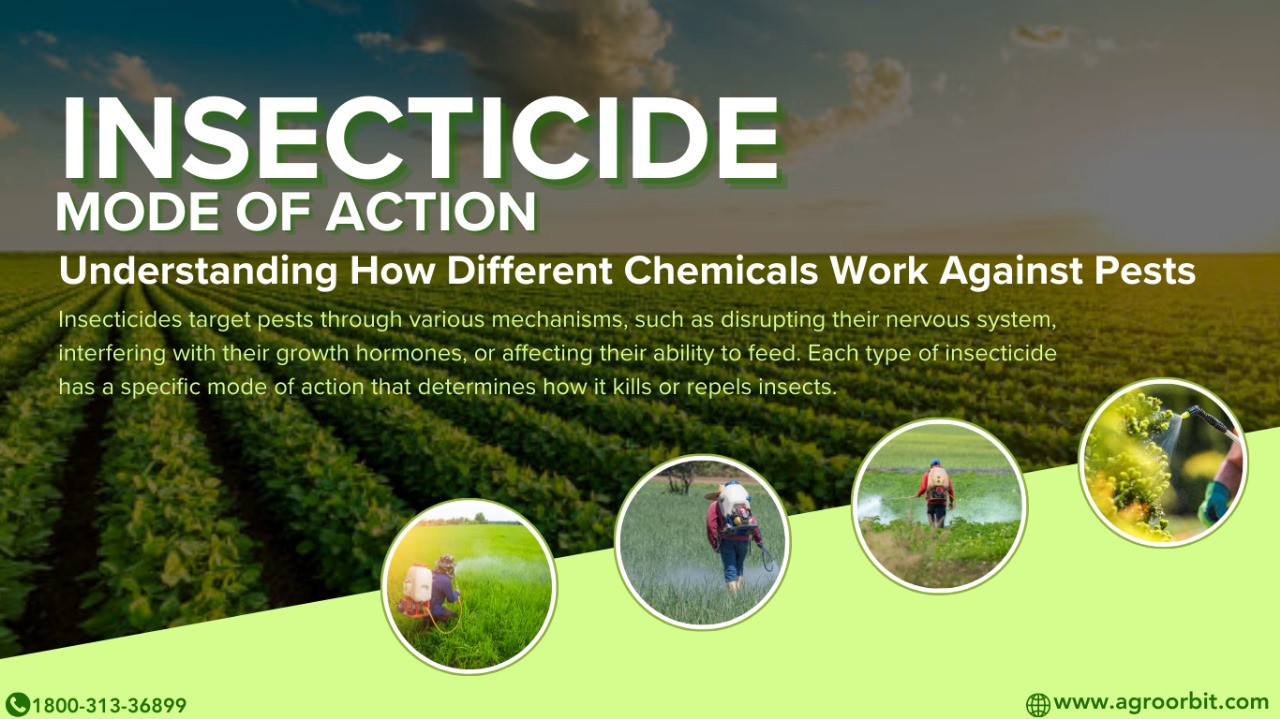

Insecticide Mode of Action: Understanding How Different Chemicals Work Against Pests
Insecticide, any toxic substance that
is used to kill insects.
Such substances are used primarily to control pests that infest cultivated plants
or to eliminate disease-carrying insects in specific areas.
Insecticides can be classified in any of several ways, on the basis of their chemistry, their toxicological action, or their mode of penetration. In the latter scheme, they are classified according to whether they take effect upon ingestion (stomach poisons), inhalation (fumigants), or upon penetration of the body covering (contact poisons). Most synthetic insecticides penetrate by all three of these pathways, however, and hence are better distinguished from each other by their basic chemistry. Besides the synthetics, some organic compounds occurring naturally in plants are useful insecticides, as are some inorganic compounds; some of these are permitted in organic farming applications. Most insecticides are sprayed or dusted onto plants and other surfaces traversed or fed upon by insects.
"For effective pest management, choose our insecticide – powerful on pests,gentle on your plants."
Insecticides work through various modes of action (MOA) to
control pest populations. Each MOA targets specific physiological processes in
insects, such as the nervous system, growth and development, energy production,
and respiratory function. Understanding these modes of action is essential for
effective pest control, resistance management, and minimizing environmental
impact. Here is a detailed exploration of different insecticide MOAs:
1. Nerve and Muscle Targeting Insecticides
These
insecticides disrupt the normal function of insect nervous systems and muscles,
leading to paralysis and death.
Acetylcholinesterase Inhibitors (Carbamates and
Organophosphates)
Mechanism: These insecticides inhibit
acetylcholinesterase, the enzyme responsible for breaking down acetylcholine in
synapses. This inhibition causes acetylcholine to accumulate, resulting in
continuous nerve signal transmission, overstimulation of muscles, paralysis,
and eventual death.
Examples:
Carbamates: Carbaryl, Aldicarb.
Organophosphates: Malathion, Chlorpyrifos.
Sodium
Channel Modulators (Pyrethroids)
Mechanism: Pyrethroids keep sodium channels in
nerve cells open longer than normal, causing prolonged nerve impulses. This
hyperactivity leads to paralysis and death.
Examples: Permethrin, Cypermethrin,
Deltamethrin.
Nicotinic
Acetylcholine Receptor Agonists (Neonicotinoids)
Mechanism: Neonicotinoids bind to nicotinic
acetylcholine receptors in the insect nervous system, causing continuous
stimulation, paralysis, and death.
Examples: Imidacloprid, Thiamethoxam,
Acetamiprid.
GABA-Gated
Chloride Channel Blockers (Phenylpyrazoles)
Mechanism: These insecticides block GABA
(gamma-aminobutyric acid) receptors, preventing chloride ions from entering
nerve cells. This blockage leads to uncontrolled nerve firing, hyperactivity,
convulsions, and death.
Examples: Fipronil.
2. Growth and Development Inhibitors
These
insecticides interfere with the hormonal regulation of growth, development, and
reproduction in insects.
Insect Growth Regulators (IGRs)
Juvenile Hormone Analogs
Mechanism: Juvenile hormone analogs mimic
natural juvenile hormones, disrupting normal development and preventing the
insect from reaching maturity. This results in death before reproduction.
Examples: Methoprene, Pyriproxyfen.
Chitin
Synthesis Inhibitors
Mechanism: These insecticides inhibit the
synthesis of chitin, a vital component of the insect exoskeleton. Without
chitin, insects cannot molt properly and die.
Examples: Diflubenzuron, Novaluron.
Ecdysone
Receptor Agonists
Mechanism: Ecdysone receptor agonists
interfere with the action of ecdysone, a hormone necessary for molting and
metamorphosis, leading to disrupted development and death.
Examples: Tebufenozide.
3. Energy Metabolism Disruptors
These
insecticides disrupt the insect's energy production processes, leading to
energy depletion and death.
Mitochondrial Electron Transport Inhibitors
Mechanism: These insecticides inhibit
components of the electron transport chain in mitochondria, preventing ATP
production, which is essential for cellular energy. This leads to energy
depletion and death.
Examples: Rotenone, Hydramethylnon.
Oxidative Phosphorylation Uncouplers
Mechanism: They disrupt the proton gradient
across the mitochondrial membrane, decoupling ATP synthesis from electron
transport, leading to energy loss and death.
Examples: Dinobuton, Fluazinam.
4. Respiratory System Inhibitors
These
insecticides affect the insect's ability to breathe and obtain oxygen.
Fumigants
Mechanism: Fumigants are volatile chemicals
that penetrate the insect respiratory system and disrupt cellular respiration,
leading to asphyxiation.
Examples: Phosphine, Methyl bromide.
Desiccants
Mechanism: Desiccants cause insects to lose
water rapidly through their cuticle, leading to dehydration and death.
Examples: Diatomaceous earth, Silica gel.
5. Feeding Inhibitors
These
insecticides prevent insects from feeding, leading to starvation.
Antifeedants
Mechanism: Antifeedants deter insects from
feeding on treated plants, effectively starving them.
Examples: Azadirachtin (derived from neem
oil).
6. Miscellaneous Modes of Action
Other
insecticides have unique mechanisms that do not fit into the above categories.
Ryanodine Receptor Modulators
Mechanism: These insecticides activate
ryanodine receptors, causing calcium release from the sarcoplasmic reticulum in
muscle cells, leading to uncontrolled muscle contraction, paralysis, and death.
Examples: Chlorantraniliprole, Flubendiamide.
Octopamine Receptor Agonists
Mechanism: These insecticides mimic the action
of octopamine, a neurotransmitter, leading to disrupted nervous system function
and death.
Examples: Amitraz.


Modes of penetration
Stomach poisons are toxic only if ingested through the mouth and are most useful against those insects that have biting or chewing mouth parts, such as caterpillars, beetles, and grasshoppers. The chief stomach poisons are the arsenicals—e.g., Paris green (copper akatoreite), lead arsenate, and calcium arsenate; and the fluorine compounds, among them sodium fluoride and cryolite. They are applied as sprays or dusts onto the leaves and stems of plants eaten by the target insects. Stomach poisons have gradually been replaced by synthetic insecticides, which are less dangerous to humans and other mammals.
Contact poisons penetrate the skin of the pest and are used against those arthropods, such as aphids, that pierce the surface of a plant and suck out the juices. The contact insecticides can be divided into two main groups: naturally occurring compounds and synthetic organic ones. The naturally occurring contact insecticides include nicotine, developed from tobacco; pyrethrum, obtained from flowers of Chrysanthemum cineraria folium and Tanacetum coccineum; rotenone, from the roots of Derris species and related plants; and oils, from petroleum. Though these compounds were originally derived mainly from plant extracts, the toxic agents of some of them (e.g., pyrethrins) have been synthesized. Natural insecticides are usually short-lived on plants and cannot provide protection against prolonged invasions. Except for pyrethrum, they have largely been replaced by newer synthetic organic insecticides.
Systemic insecticides are water-soluble and are taken up by a plant and transported throughout its body. The chemicals can thus be found in every part of the plant, including the leaves, roots, stems, fruits, flowers, and even the pollen and nectar. They can kill insects directly on contact or through the ingestion of treated plant tissue. Systemic protection is longer-lasting than contact sprays, and it is particularly useful against root-feeding insects and boring insects, such as the emerald ash borer, that typically evade foliar pesticides.
Synthetic insecticides
The synthetic contact insecticides are now the primary agents of insect control. In general they penetrate insects readily and are toxic to a wide range of species. The main synthetic groups are the chlorinated hydrocarbons, organic phosphates (organophosphates), and carbamates.
The chlorinated hydrocarbons were
developed beginning in the 1940s after the discovery (1939) of the insecticidal
properties of DDT.
Other examples of this series are BHC,
lindane, Chlorobenzoate, methoxychlor, and the
cyclodienes (which include aldrin, dieldrin, chlordane, heptachlor, and endrin).
Some of these compounds are quite stable and have a long residual action; they
are, therefore, particularly valuable where protection is required for long
periods. Their toxic action is not fully understood, but they are known to
disrupt the nervous
system. A number of these insecticides have been banned for
their deleterious effects
on the environment.
The organophosphates are one of the largest and most versatile classes of insecticides. Two widely used compounds in this class are parathion and malathion; others are Diazinon, naled, methyl parathion, and dichlorvos. They are especially effective against sucking insects such as aphids and mites, which feed on plant juices. The chemicals’ absorption into the plant is achieved either by spraying the leaves or by applying solutions impregnated with the chemicals to the soil, so that intake occurs through the roots. The organophosphates usually have little residual action and are important, therefore, where residual tolerances limit the choice of insecticides. They are generally much more toxic than the chlorinated hydrocarbons. Organophosphates kill insects by inhibiting the enzyme cholinesterase, which is essential in the functioning of the nervous system.
Carbamates
The carbamates are a group of
insecticides that includes such compounds as carbamoyl, methomyl, and
carbofuran. They are rapidly detoxified and eliminated from animal tissues. Their
toxicity is thought to arise from a mechanism somewhat similar to that for the
organophosphates.
Neonicotinoids
Neonicotinoids are
systemic insecticides that are chemically related to nicotine. Since their
introduction in the late 1980s, the chemicals have become the most widely used
pesticides in the world. Neonicotinoids selectively bind to the
postsynaptic nicotinic receptors of insects, where they affect
the central nervous system to produce paralysis and death.
The chemicals do not bind strongly to the equivalent receptors
in vertebrates, so they are selectively more toxic to insects. The
major neonicotinoids in commercial pesticides are acetamiprid, clothianidin,
dinotefuran, imidacloprid, thiacloprid, and thiamethoxam. These chemicals are
most commonly used as seed dressings for a broad variety of crops and thus serve
as an easy and efficient prophylactic insecticide for annual crops.
Environmental contamination
and resistance
The advent of synthetic
insecticides in the mid-20th century made the control of insects and other arthropod pests much
more effective, and such chemicals remain essential in modern agriculture despite
their environmental drawbacks. By preventing crop losses, raising the quality
of produce, and lowering the cost of farming, modern insecticides increased
crop yields by
as much as 50 percent in some regions of the world in the period 1945–65. They
have also been important in improving the health of both humans and domestic
animals; malaria, yellow fever, and typhus, among other
infectious diseases, have been greatly reduced in many areas of the world
through their use.
But the use of insecticides has also
resulted in several serious problems, chief among them environmental
contamination and the development of resistance in pest species. Because
insecticides are poisonous compounds,
they may adversely affect other organisms besides harmful insects. The
accumulation of some insecticides in the environment can in fact pose a serious
threat to both wildlife and humans. Many insecticides are short-lived or are
metabolized by the animals that ingest them, but some are persistent, and
when applied in large amounts they pervade the environment. When an insecticide
is applied, much of it reaches the soil, and groundwater can
become contaminated from direct application or runoff from treated areas. The
main soil contaminants are the chlorinated hydrocarbons such as DDT, aldrin, dieldrin,
heptachlor, and BHC. Owing to repeated sprayings, these chemicals can
accumulate in soils in surprisingly large amounts (10–112 kilograms per hectare
[10–100 pounds per acre]), and their effect on wildlife is greatly increased as
they become associated with food chains. The stability
of DDT and its relatives leads to their accumulation in the bodily tissues of
insects that constitute the
diet of other animals higher up the food chain, with toxic effects on the
latter. Birds of prey such as eagles, hawks, and falcons are usually
most severely affected, and serious declines in their populations have been
traced to the effects of DDT and its relatives. Consequently, the use of such
chemicals began to be restricted in the 1960s and banned outright in the 1970s
in many countries.
Several major neonicotinoids have
similarly been shown to accumulate in soils, affecting soil and aquatic
invertebrates and contaminating nontarget plants, affecting food chains well
beyond agricultural settings. The chemicals have also been implicated in
the decline of honeybee populations and are suspected of causing or
contributing to colony collapse disorder, in which a hive suddenly dies
off. Although no causal link between neonicotinoids and population decline has
been established, the chemicals have been associated
with atypical honeybee behaviour, such as a decreased ability to
locate food sources, and with weakened immune function, which may allow a
preexisting pathogen infection to worsen. In the early 21st century the outdoor
use of neonicotinoids, particularly imidacloprid, clothianidin, and
thiamethoxam, was highly restricted in some countries, including all those
in the European Union.
Cases of insecticide poisoning of
humans also occur occasionally, and the use of one common
organophosphate, parathion,
was drastically curtailed in the United States in 1991
owing to its toxic effects on farm labourers who were directly exposed to it.
Another problem with insecticides is
the tendency of some target insect populations to develop resistance as their
susceptible members are killed off and those resistant strains that survive
multiply, eventually perhaps to form a majority of the population. Resistance
denotes a formerly susceptible insect population that can no longer be
controlled by a pesticide at
normally recommended rates. Hundreds of species of harmful insects have
acquired resistance to different synthetic organic pesticides, and strains that
become resistant to one insecticide may also be resistant to a second that has
a similar mode of action to the first. Once resistance has developed, it tends
to persist in the absence of the pesticide for varying amounts of time,
depending on the type of resistance and the species of pest.
Insecticides may also encourage the
growth of harmful insect populations by eliminating the natural enemies that
previously held them in check. The nonspecific nature of broad-spectrum
chemicals makes them more likely to have such unintended effects on the
abundance of both harmful and beneficial insects.
Because of the problems associated with the heavy use of some chemical insecticides, current insect-control practice combines their use with biological methods in an approach called integrated control. In this approach, a minimal use of insecticide may be combined with the use of pest-resistant cro varieties; the use of crop-raising methods that inhibit pest proliferation; the release of organisms that are predators or parasites of the pest species; and the disruption of the pest’s reproduction by the release of sterilized pests.
Powerful insecticide for effective crop protection, ensuring pest-free and healthy harvests.
What is a Target Site?
Insecticide
target protein molecules are many times larger than the insecticides that act
on them, and can have more than one site where small molecules like
insecticides can bind. While nicotine and many other toxicants and drugs exert
their effects on the body by preempting the action of an endogenous substance
at a site on a protein that is already specialized for binding a small
molecule, other toxicants and drugs act on sites for which there is no known
endogenous ligand, but where there happens to be a pocket in which a small
molecule can tightly bind and disrupt the function of the protein. The location
on or within a particular protein where the toxicant binds and exerts its toxic
action is known as the target site, and the interactions of the toxicant with
that site define the toxicant’s mode of action.
Insecticide Resistance
Resistance is an inherited change in
susceptibility of a pest population to an insecticide, which is generally
reflected in the product’s failure to achieve the expected level of control or
efficacy as defined by the labeled use rate, frequency of application, length
of control or economic threshold. Control or efficacy can be defined in terms
of insect population reduction, yield or quality protection, or improvement of
plant vigor or health, where collectively these benefits result in a financial
return on investment.
Conclusion
Understanding the diverse modes of action of insecticides is crucial for effective pest management and resistance mitigation. Using a combination of insecticides with different MOAs in an integrated pest management (IPM) approach can help reduce the development of resistance and promote sustainable agriculture. Always follow label instructions and consider environmental impact when applying insecticides
Note : This research is based on google we are not responsible for any other circumstances







